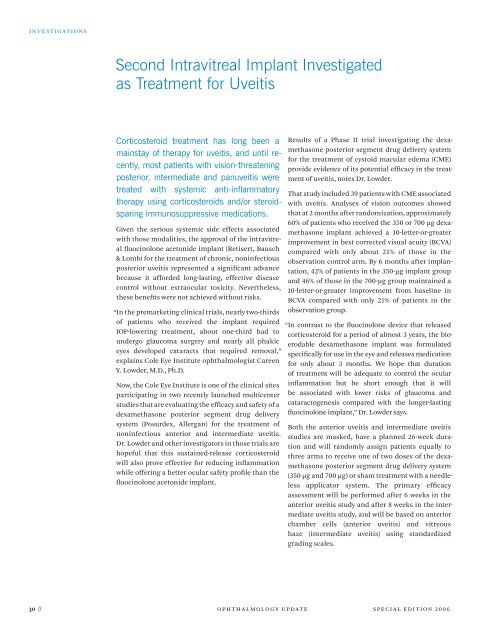Ophthalmology Update - Cleveland Clinic
Ophthalmology Update - Cleveland Clinic
Ophthalmology Update - Cleveland Clinic
You also want an ePaper? Increase the reach of your titles
YUMPU automatically turns print PDFs into web optimized ePapers that Google loves.
i n v e s t i g a t i O n s<br />
Second Intravitreal Implant Investigated<br />
as Treatment for Uveitis<br />
Corticosteroid treatment has long been a<br />
mainstay of therapy for uveitis, and until recently,<br />
most patients with vision-threatening<br />
posterior, intermediate and panuveitis were<br />
treated with systemic anti-inflammatory<br />
therapy using corticosteroids and/or steroidsparing<br />
immunosuppressive medications.<br />
given the serious systemic side effects associated<br />
with those modalities, the approval of the intravitreal<br />
fluocinolone acetonide implant (retisert, Bausch<br />
& lomb) for the treatment of chronic, noninfectious<br />
posterior uveitis represented a significant advance<br />
because it afforded long-lasting, effective disease<br />
control without extraocular toxicity. nevertheless,<br />
these benefits were not achieved without risks.<br />
“in the premarketing clinical trials, nearly two-thirds<br />
of patients who received the implant required<br />
iOp-lowering treatment, about one-third had to<br />
undergo glaucoma surgery and nearly all phakic<br />
eyes developed cataracts that required removal,”<br />
explains cole eye institute ophthalmologist careen<br />
y. lowder, m.d., ph.d.<br />
now, the cole eye institute is one of the clinical sites<br />
participating in two recently launched multicenter<br />
studies that are evaluating the efficacy and safety of a<br />
dexamethasone posterior segment drug delivery<br />
system (posurdex, allergan) for the treatment of<br />
noninfectious anterior and intermediate uveitis.<br />
dr. lowder and other investigators in those trials are<br />
hopeful that this sustained-release corticosteroid<br />
will also prove effective for reducing inflammation<br />
while offering a better ocular safety profile than the<br />
fluocinolone acetonide implant.<br />
results of a phase ii trial investigating the dexamethasone<br />
posterior segment drug delivery system<br />
for the treatment of cystoid macular edema (cme)<br />
provide evidence of its potential efficacy in the treatment<br />
of uveitis, notes dr. lowder.<br />
that study included 39 patients with cme associated<br />
with uveitis. analyses of vision outcomes showed<br />
that at 2 months after randomization, approximately<br />
60% of patients who received the 350 or 700 µg dexamethasone<br />
implant achieved a 10-letter-or-greater<br />
improvement in best corrected visual acuity (Bcva)<br />
compared with only about 21% of those in the<br />
observation control arm. By 6 months after implantation,<br />
42% of patients in the 350-µg implant group<br />
and 46% of those in the 700-µg group maintained a<br />
10-letter-or-greater improvement from baseline in<br />
Bcva compared with only 21% of patients in the<br />
observation group.<br />
“in contrast to the fluocinolone device that released<br />
corticosteroid for a period of almost 3 years, the bioerodable<br />
dexamethasone implant was formulated<br />
specifically for use in the eye and releases medication<br />
for only about 3 months. We hope that duration<br />
of treatment will be adequate to control the ocular<br />
inflammation but be short enough that it will<br />
be associated with lower risks of glaucoma and<br />
cataractogenesis compared with the longer-lasting<br />
fluocinolone implant,” dr. lowder says.<br />
Both the anterior uveitis and intermediate uveitis<br />
studies are masked, have a planned 26-week duration<br />
and will randomly assign patients equally to<br />
three arms to receive one of two doses of the dexamethasone<br />
posterior segment drug delivery system<br />
(350 µg and 700 µg) or sham treatment with a needleless<br />
applicator system. the primary efficacy<br />
assessment will be performed after 6 weeks in the<br />
anterior uveitis study and after 8 weeks in the intermediate<br />
uveitis study, and will be based on anterior<br />
chamber cells (anterior uveitis) and vitreous<br />
haze (intermediate uveitis) using standardized<br />
grading scales.<br />
0 // O p h t h a l m O l O g y U p d a t e s p e c i a l e d i t i O n 2 0 0 6
















